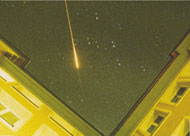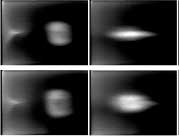 August 2001 issue
August 2001 issue![]()
Thanks to self-focusing, laser pulses can be launched upward into clouds where they can be used to measure pollutants.
Like many things in physics, refractive index isn't as simple as we learned in high school. In addition to the familiar constant is a term that depends on intensity: n = n0 + n2 I.
This intensity dependence, known as the optical Kerr effect, underlies the phenomenon of self-focusing. If a beam of light is brighter in the center than at the edges--as most are--the center will encounter a bigger refractive index and slow down. Wavefronts that start out planar will therefore collapse about the center. A tighter beam results.
For air, n2 is so tiny that the power must exceed several gigawatts for self-focusing to kick in. Only strongly focused or ultrashort-pulse lasers can provide such prodigious power. (For more on powerful ultrashort lasers, see the article by Gérard Mourou, Christopher Barty, and Michael Perry, Physics Today, January 1998, page 22.*)
In 1994, soon after ultrashort lasers came on line, Mourou and his group at the University of Michigan fired 10-GW, 200-fs pulses across their lab through air. Their goal was to mimic a pulsed microwave radar with light. Along with the expected self-focusing, they discovered something else.1 To their surprise, the narrowed pulses, which they termed filaments, acted as their own waveguides, retaining their width and propagating across the lab for tens of meters.
In this and other experiments, it became apparent that plasma formation plays a key role in the filament propagation. Self-focusing increases the intensity, which leads to greater self-focusing, which further increases the intensity. What halts this runaway process is ionization.
When self-focusing pushes I above 1014 W cm-2, multiphoton ionization creates a plasma, whose refractive index, being less than air's, causes the beam to defocus. Without self-focusing to boost it, I drops below the ionization threshold. The Kerr effect switches back on, and self-focusing resumes. The filaments' propagation depends, therefore, on a quasi-dynamic equilibrium between Kerr focusing and plasma defocusing.
At high intensities, slight irregularities in the beam profile act as seeds for the filaments, which travel together in parallel. This phenomenon, known as modulation instability, causes each stable filament in a 100-fs beam to draw roughly one millijoule of energy from the initial pulse. In a sense, the filaments are quantized.
Now, a more detailed view of filament propagation has been obtained, thanks to experiments at the Ecole Nationale Supérieure de Techniques Avancées (ENSTA) and the Ecole Polytechnique in Palaiseau, France. Stelios Tzortzakis, his thesis adviser André Mysyrowicz, and their colleagues Michel Franco and Bernard Prade have followed the self-focusing process as it happens. Their experiments reveal that filaments propagate by carefully husbanding their energy through merging.2 If a beam breaks into two filaments, those two filaments will combine before the intensity of either drops below the threshold for self-focusing.
 |
|
|
 |
|
|
Figure 3 encapsulates the main finding of the ENSTA team. There we see that when the power is high enough to form filaments, those filaments, after propagating a few meters, fuse to form a single filament, which continues to propagate.
 |
|
|
Bergé and Couairon's model followed an approach devised two years ago by the University of Arizona's Michal Mlejnek, Miroslav Kolesik, Jerry Moloney, and Ewan Wright.3 (Mlejnek now works for Corning Inc.) As their starting point, the Arizona group used the nonlinear Schrödinger (NLS) equation. "The NLS is a natural," explains Moloney. "It describes weakly nonlinear dispersive behavior in any physical system--optical propagation, water waves, or plasma instabilities in Langmuir turbulence."
Like the self-focusing itself, solutions to the NLS evolve toward a singularity unless something steps in to avert that fate. In the Arizona model, multiphoton ionization, as embodied in a plasma model, plays the role of moderator.
Averting the singularity is more than a matter of mathematical neatness. Multiphoton ionization costs less energy than the processes that would occur if self-focusing proceeded further. Filaments are able to propagate because multiphoton ionization causes diffraction that temporarily spreads the filaments' energy but doesn't absorb much of it.
Foreshadowing Tzortzakis's experiments, the Arizona model produced filaments that propagated, merged, and then continued to propagate. Unlike the ENSTA experiments, the Arizona model wasn't constrained by the output power of real lasers and could produce up to 30 filaments. The laser that Tzortzakis used could produce two.
But in a new set of experiments with a more powerful laser, Tzortzakis hopes to test a key prediction of the Arizona model: that a beam of, say, 10 filaments would merge, then, having lost some energy because of ionization, would break up again into a smaller number of filaments, say, 8, that would merge and break up yet again.
Although the self-guided filaments are intense, they contain just a few millijoules of energy--far too low for use as Star Trek phasers, let alone photon torpedoes. But they are potentially useful even so.
Under the extreme conditions of filament formation, nonlinear effects convert the initially monochromatic light to a continuum that stretches from 300 nm in the ultraviolet to 4.5 mm in the infrared. Couple this property with the filaments' ability to travel undispersed over long distances, and one has the potential to do remote spectroscopy of atmospheric pollutants.
Laser pulses are already used to map pollutants in the atmosphere. The technique, known as lidar, involves launching two laser beams into the atmosphere. One beam is tuned to an absorption band of the pollutant of interest; the other acts as a reference. The two beams--one diminished by absorption, the other not--scatter off nitrogen and oxygen molecules or dust particles in the atmosphere. A detector on the ground measures the backscattered fraction of each beam.
This, the traditional form of lidar, suffers from three drawbacks that don't beset self-focused filaments.
In addition to these advantages, self-focused filaments share one of traditional lidar's useful properties: the ability to exploit the delay time of reflected pulses to yield distance information.
Exploiting self-focused filaments for detecting pollutants is one of the aims of Teramobile, a mobile terawatt laser.5 The nine-ton facility, which fits in a standard cargo container, is a joint project of two French and two German research groups: Mysyrowicz's at ENSTA, Jean-Pierre Wolf's at Claude Bernard University in Lyons, Roland Sauerbrey's at Friedrich Schiller University in Jena, and Ludger Wöste's at Berlin's Free University.
In its four-month life, Teramobile has already detected water and methane in the atmosphere. "Now we want to attack the real pollutants," says Wöste. Those experiments begin this month in Jena.
Charles Day